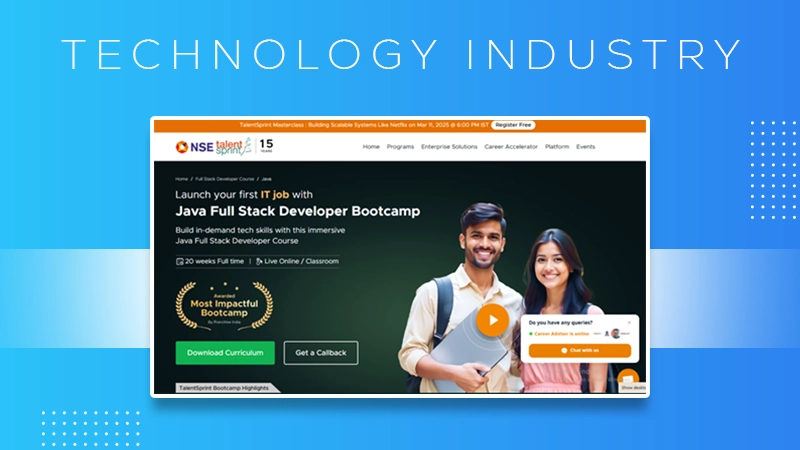
Your attitude, not your aptitude, will determine your altitude.
–Zig Ziglar (American author)
Information Technology, or the IT sector, is an evergreen field that has millions of job opportunities across the world. The size of the global IT industry market was valued at $11681.64 billion in 2024, showcasing its growth over the years and making it one of the most important fields.
People dream of working in big IT corporations because it offers several perks, including a handsome salary, traveling around the world, and other incentives. But it’s not easy to get in here, especially if you don’t understand the complete process.
Based on my experiences and advice taken from IT professionals, I’ll be telling you about these 7 steps that will help any individual get their dream job.
1. Define Your Niche and Skillset
Information Technology is a vast field and includes several things like cybersecurity, data science, administration and more. That’s why it is essential for you to figure out what are your expertise and areas of industry.
There are hundreds of roles that might go with your skill set, and it’s important to do proper research first and see what aligns with your capabilities. However, it’s important to have all the knowledge of things you are claiming to be expert in because a recruiter will ask question and upon failing to answer them chances of getting the job will decrease.
2. Opt for a Bootcamp

New things are included in this industry nearly every month, and it’s important to stay ahead of the curve. If you don’t feel confident enough, you can join bootcamps like Java Full Stack course, which takes care of all the requirements and needs.
It is fully equipped with HTML, CSS, JavaScript, React, Java, Spring Boot, and database knowledge. As you can see, it covers all the essential areas of expertise and would ensure that you are up-to-date with the latest trends. Learning new skills or languages will only benefit you in the long run.
3. Build a Strong Online Presence
Online presence holds quite a lot of importance these days, and you should have one. I’m not asking you to be an influencer or anything, but you need to have an active professional LinkedIn work profile that is consisted of all your previous experiences, achievements and skills.
Another way is creating a portfolio website or GitHub repository to showcase all your best projects that would demonstrate your technical abilities as well. In case you were going to apply for web design or software development, this is a must.
4. Networking
The goal here is not only to find a job, it is to build strong relationships as well. IT revolves around networking, and it is the key to breaking into this world. Attend as many conferences, events, tech meetups as you can to connect with other professionals who can give you valuable insights.
If being physically present is not possible for someone, they can join online forums and communities. Here, they can engage in dialogue on various topics and expand their knowledge.
LinkedIn is a great platform to do all this, and in the infographic below, you see the different benefits of networking.

5. Craft a Compelling Resume and Cover Letter
Whenever you are invited somewhere for an interview, the first thing they will ask for is your resume and cover letter. It’s the first impression to the recruiter, and it will decide whether you’ll be getting the job or not.
It should consist of your best work and recommendations from good places. Apart from that, include keywords from the job profile so the applicant tracking systems (ATS) will capture that. Your bio also needs to be on point and catch the immediate attention of the person reading it.
Explain your roles and achievements and how they affected the previous company. But don’t go into too much detail, or the resume will become lengthy, and the employer will lose interest.
A platform like Rezi can assist you in optimizing your resume for ATS screening and showcasing the most relevant achievements for the position you want. It also helps you format your information so it stays clear while still leaving a strong impression.
6. Prepare for Technical Interviews

Technical interviews can be more difficult because they test the skills of an individual by giving different tasks like practice coding challenges, system design questions, and behavioral questions.
It’s nothing to be afraid of, but would require some practice beforehand. Familiarize yourself with common questions and create some of your own that you can ask them. But be professional about it, and avoid asking stupid or irrelevant questions.
Several online platforms help with interviews; including Interview Cake, LeetCode, HackerRank.
7. Leverage Job Boards and Company Websites
Nowadays, everything has been digitalized, and this has greatly benefited us. For example, it has become easier to find jobs on sites like Indeed, LinkedIn, Glassdoor, and Dice. From here, you can even find the direct website of the companies and set reminders for upcoming openings.
You can also change the search settings based on your choices and preferences. Consider applying to small companies or startups if they are offering unique opportunities that can further boost your portfolio.
FUN FACTJagdeep Singh, CEO and founder of QuantumScape, is known as the world’s highest-paid employee, earning $2.95 billion annually!
Conclusion
Getting an IT job is not that simple; there are millions just like you who want the same job, but the one who stands out the most will get it. Always use a strategic approach and be dedicated to whatever you are doing.
Opt for Java bootcamps for advanced training on in-demand skills that will make you a more appealing candidate. Be focused and never get disheartened if you get rejected; it’s all part of the journey, just keep on working hard.